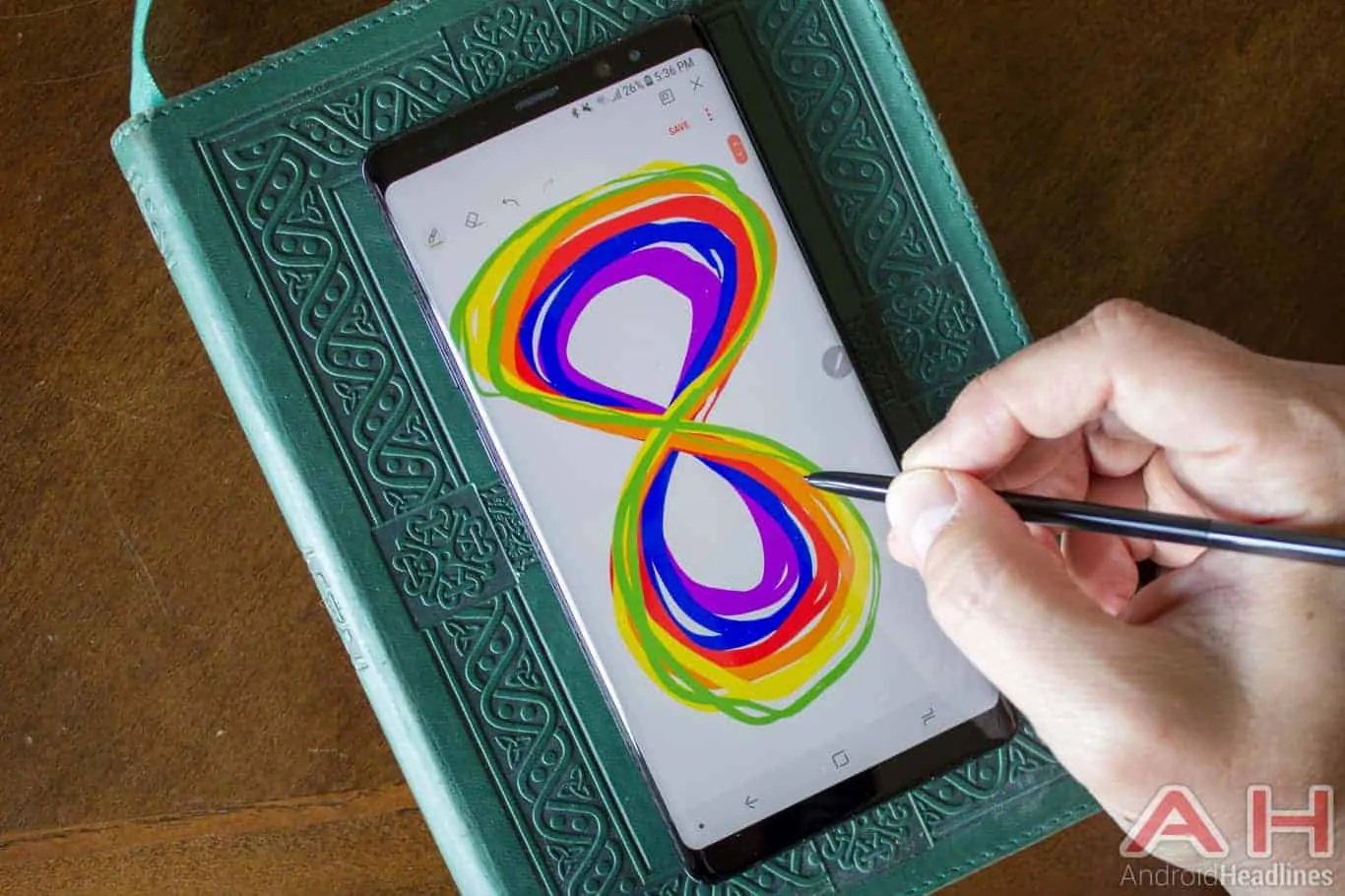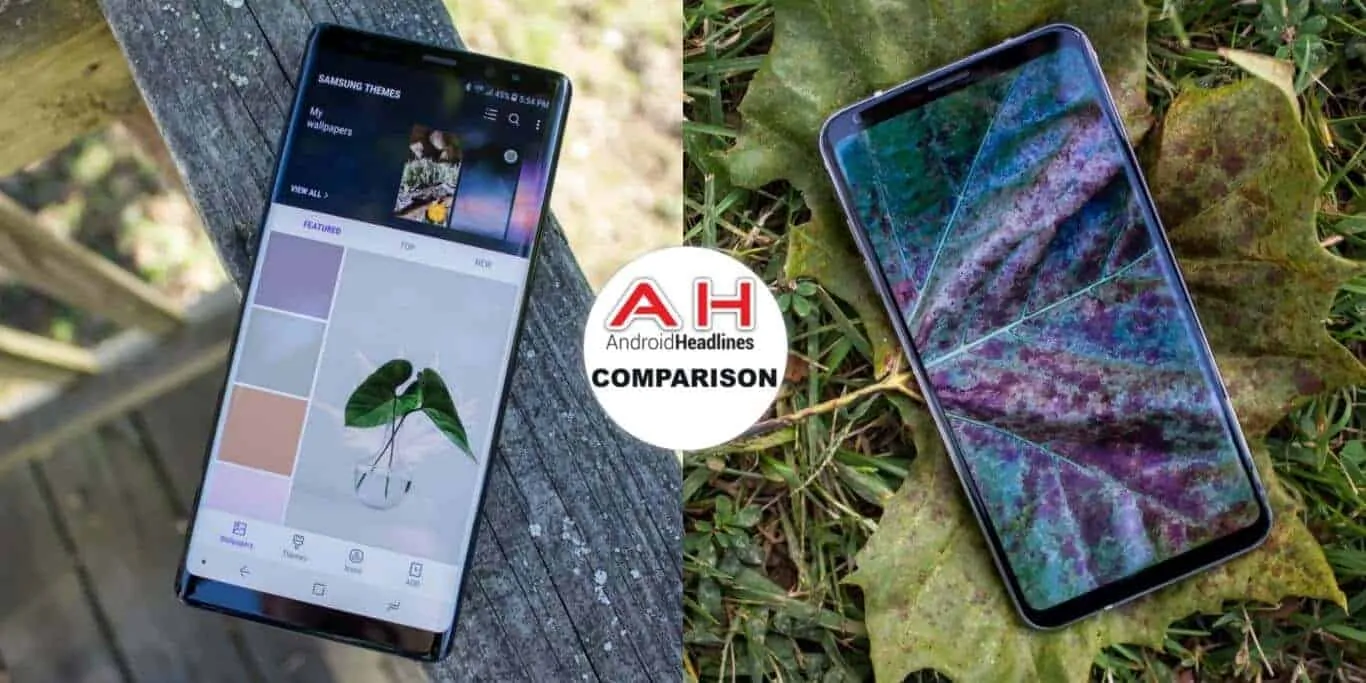Introduction
Do we have a powerhouse comparison today as the mighty Samsung Galaxy Note 8 takes on the new and improved LG V30. Both devices are beautiful to look at and both pack in the latest technology, but both are geared towards a different audience. The Galaxy Note 8 is looking to re-establish Samsung’s strong hold in the business arena after the Galaxy Note 7 debacle in 2016. The Note 8 is the only device on the market with a true stylus and apps that make note-taking and drawing a breeze. The LG V30 is going after the photographer with its dual cameras and the audio buff with its four DACs. The LG V30 puts out some great sounds as long as you are wearing headphones (as you will find only one speaker on the device). Today we are going look at these two high priced devices to determine a winner. Before we examine each individual device, we will first see what these two flagships have in common.
The gap is narrowing between the Galaxy Note 8 and the LG V30. LG dropped its LCD technology and turned to an P-OLED display. Samsung finally broke from a single camera and added dual cameras to the Note 8. The 18:9 displays are close to the same size as both devices hit the six-inch mark. Each device has a notification system on the primary display – Samsung uses the ‘always-on’ method and LG uses a floating secondary display. The Snapdragon 835 processor and Adreno 540 GPU are found in both devices. Each uses 64GB of expandable memory and both use a dual-camera setup. A 3,300 mAh battery powers both devices and both have fast charging and wireless charging support. Both devices use BT 5.0 and incorporate a rear-mounted fingerprint sensor. The share Hi-Res audio, an IP68 rating, a 3.5mm headphone jack, USB Type-C port, and both offer facial recognition.
Please take a thoughtful look at the detailed specifications comparison chart below and here you will see just how these two great devices stack up against one another. After that, we will look at each device in greater depth and point out some of its pros and cons. From all of this information, we will try to determine the winner based on specs and execution of design and functions.
Specifications

Samsung Galaxy Note 8
 This year, Samsung introduced a new Infinity Display on its Galaxy S8/S8 Plus models and included it on the Galaxy Note 8. It gives us an 18.5:9 aspect ratio for a better entertainment experience. It has a dual curved display that wraps around the edges and seamlessly blends into the back, eliminating any side bezels. The viewing area is literary to the edge. Samsung also eliminated the physical home button as the Note 8 now uses onscreen buttons – that are there only when you need them. The top and bottom bezels are very small on this large device with nothing on the bottom bezel and only the indicator light, proximity sensor, speaker, and front-facing camera on the top bezel. The front camera is used for facial recognition and iris scanning. Samsung opted to include a dual rear camera setup on the Note 8; however, the fingerprint sensor is still in an awkward position on the back next to the camera. Thankfully, at least when there is light, you can unlock the phone rather quickly with the facial recognition or iris scanner (if you do not wear glasses). If all else fails, one can always fall back on using a pin for unlocking the Note 8. Samsung made improvements to the S-Pen and software to make it easier to use and more productive. The Galaxy Note 8 is arguably the best looking and most feature laden smartphone on the market, however, all of this technology comes at a cost of approximately $960.
This year, Samsung introduced a new Infinity Display on its Galaxy S8/S8 Plus models and included it on the Galaxy Note 8. It gives us an 18.5:9 aspect ratio for a better entertainment experience. It has a dual curved display that wraps around the edges and seamlessly blends into the back, eliminating any side bezels. The viewing area is literary to the edge. Samsung also eliminated the physical home button as the Note 8 now uses onscreen buttons – that are there only when you need them. The top and bottom bezels are very small on this large device with nothing on the bottom bezel and only the indicator light, proximity sensor, speaker, and front-facing camera on the top bezel. The front camera is used for facial recognition and iris scanning. Samsung opted to include a dual rear camera setup on the Note 8; however, the fingerprint sensor is still in an awkward position on the back next to the camera. Thankfully, at least when there is light, you can unlock the phone rather quickly with the facial recognition or iris scanner (if you do not wear glasses). If all else fails, one can always fall back on using a pin for unlocking the Note 8. Samsung made improvements to the S-Pen and software to make it easier to use and more productive. The Galaxy Note 8 is arguably the best looking and most feature laden smartphone on the market, however, all of this technology comes at a cost of approximately $960.
Samsung continued with their Infinity Display, but used a much larger 6.3-inch display with a new 18.5:9 aspect ratio. Of course we will find Samsung’s Super AMOLED technology with a higher QHD+ display resolution of 2960 x 1440 generating 521 pixels-per-inch (PPI). Samsung has set the Note 8 to default to 220 x 1080 to save battery life, but within the settings, you can always bump it up. Samsung continues using its ‘always-on’ display to make it easier and quicker to check notifications, and by using this technology, it also helps to save battery life. The Galaxy Note 8 uses the new Qualcomm Snapdragon 835 octa-core processor – as does the Galaxy S8 and the LG V30 – or Samsung’s excellent Exynos 8895 octa-core, both with the new 10nm technology. The US/China model uses the SD 835 clocked at 2.35 GHz with an Adreno 540 GPU for graphics, while other EMEA countries will see the Exynos 8895 clocked at 2.3 GHz and the Mali-G71 MP20 GPU for graphics. Samsung finally increased the memory in the Galaxy Note 8 to a full 6GB of DDR4 RAM and gave it 64GB of expandable memory via a microSD card.
Long-standing rumors of Samsung going to a dual camera system have come to fruition as the Galaxy Note 8 uses dual 12MP sensors. The primary camera has a large aperture of f/1.7 for low light conditions, PDAF, a dual-tone LED flash, auto HDR, OIS, and 2X Optical Zoom. The secondary camera is no slouch either as it carries all of the same attributes except it opts for a smaller, f/2.4 aperture. While most photos are taken with the primary camera, the secondary camera will allow the user to create photos with a bokeh effect. This is where you select the object you want to focus on and then blur the background. Samsung uses a hefty 8MP front-facing camera (FFC) along with an f/1.7 aperture, auto-HDR, and autofocus. The non-removable 3,300 mAh battery – although rather small for such a large and powerful device – should easily make it through the day. When you do need to charge the Note 8, it features Adaptive Fast Charging and Quick Wireless Charging for both Qi and PMA format.
Many of the new features are carryovers from the Galaxy S8 – the Samsung Connect feature that allows you to control Samsung’s appliances and other home controls, such as the thermostat, a DeX Station that will interface the Galaxy Note 8 with a monitor, keyboard, and mouse to give you a near-desktop experience, and its own personal assistant called Bixby. Like other personal assistants, you can ask Bixby simple questions and receive an answer, although it also offers the ability to provide information from a picture via the camera and can translate words on a sign via the camera. The Galaxy Note 8 keeps Samsung’s popular heart rate monitor and oxygen saturation sensor. Samsung devices, like the Note 8, give you the ability to access not only Android Pay, but also Samsung Pay opening up even more possibilities to make mobile payments. The Galaxy Note 8 series is IP68 certified against dust and water resistance. It arrives with Android 7.1.1 (Nougat), measures 162.5 x 74.8 x 8.6 mm, and weighs in at a hefty 195 grams. It is available in Midnight Black, Orchid Grey, Maple Gold, or Deep Sea Blue depending where you are located. The Galaxy Note 8 will cost about $960 outright and is available for purchase from just about everywhere.
LG V30
 LG is not afraid to try something new – we saw that with the LG G5’s module design – and when the company sat down to design the new LG V30, it made changes as well. LG went away from the all-metal design of the LG V10 and V20 and opted for a glass back on the V30. This switch-over to glass forced LG to offer a non-removable battery, which strays from LG’s long tradition of offering removable batteries. This move also allowed LG to offer wireless charging in the new V30. LG also broke its reliance on using the LCD display technology and jump on the OLED bandwagon. LG also followed the trend from the 16:9 aspect ratio toward the 18:9 ratio, which allows the V30 to have a larger display than the V20, but a smaller footprint. LG went with the top processor on the market for its new flagship, the Snapdragon 835, while also retaining the Hi-Res audio circuitry that works great with a pair of headphones, but the LG V30 still only has one speaker.
LG is not afraid to try something new – we saw that with the LG G5’s module design – and when the company sat down to design the new LG V30, it made changes as well. LG went away from the all-metal design of the LG V10 and V20 and opted for a glass back on the V30. This switch-over to glass forced LG to offer a non-removable battery, which strays from LG’s long tradition of offering removable batteries. This move also allowed LG to offer wireless charging in the new V30. LG also broke its reliance on using the LCD display technology and jump on the OLED bandwagon. LG also followed the trend from the 16:9 aspect ratio toward the 18:9 ratio, which allows the V30 to have a larger display than the V20, but a smaller footprint. LG went with the top processor on the market for its new flagship, the Snapdragon 835, while also retaining the Hi-Res audio circuitry that works great with a pair of headphones, but the LG V30 still only has one speaker.
Using an OLED display on the V30 is not LG’s first rodeo as an OLED display can also be found on the flexible G Flex. The LG V30 sports a 6-inch QHD display with a resolution of 2880 x 1440 resulting in a 538 PPI. LG calls its new display ‘FullVision.’ The display incorporates Dolby Vision and HDR 10 support to give the user a greater entertainment experience. LG changed up the aspect ratio to 18:9 and did away with their fixed, secondary display at the top of the main display like the LG V20. LG’s new notification system is described as a ‘floating bar’ that can be swiped out of the way. The LG V30 is packing a Snapdragon 835 processor clocked at 2.45 GHz that adds speed, more capabilities, and better battery life. It uses the Adreno 540 GPU for stunning graphics. LG added the standard flagship RAM of 4GB and 64GB of expandable memory.
LG’s ‘V’ series has always included dual cameras and the LG V30 continues that configuration, only with improvements. The primary camera uses a 16MP sensor, OIS, laser and PDAF for focusing, dual-tone LED flash, and a large f/1.6 aperture for lowlight shots. This camera will take most of your everyday shots while the secondary camera will be for your wide-angle photos. The second camera does not have all of the features of the primary camera, but uses a respectable 13MP sensor with a wide-angle 120-degree field and an aperture of f/1.9. The FFC is the same 5MP used on the LG V20, but adds facial recognition to go along with selfies and video chats. A 3,300 mAh non-removable battery that offers Quick Charge 3.0, as well as wireless charging, provides power to the V30. Most users will not be happy about the switch to the non-removable battery, but that is certainly the trend with most smartphones. On the upside, you are getting IP68 water-resistance.
The LG V30 is certainly an upgrade over its LG V20 predecessor. It keeps much of the good features – the four DAC (Digital-to-Analog Converters), the EQ with left/right balance controls and B&O Play certifications. With the V30, even with the glass back, you still have the MIL-STD-810G certification and because of the glass back and non-removable battery the V30 now offers IP68 water-resistance. Improvements include the P-OLED technology used for the larger display, giving you blacker blacks and richer colors. The main camera area improves all around and now adds facial recognition to go along with voice recognition. The battery is slightly larger, non-removable, and now offers wireless charging. The device measures 151.7 x 75.4 x 7.4 mm and weighs in at 158 grams. The V30 comes in your choice of Cloud Silver or Moroccan Blue and will come with Android 7.1.2. The LG V30 will cost you approximately $840 outright.
…And The Winner Is…

The Final Word
This was one of the toughest decisions to make as the Galaxy Note 8 and LG V30 are really targeting different audiences – not to mention that the Note 8 will cost you about $120 more than the LG V30. Both devices offer an excellent experience and share the same processor/GPU offering a similar performance, although the extra 2GB of RAM in the Note 8 does help in multitasking and speed. Some buyers will demand having an S-Pen, while others could care less. Both of these flagships deserve your attention and consideration.
However, there is just something about the new Note 8 that makes it worth that extra cash. The Infinity Display and lack of side bezels must be experienced to fully appreciate it. The Note 8 has a larger and the better Super AMOLED display. The Note 8 also has more RAM and the ability to use the S-Pen and associated software. This is one beautiful smartphone that offers so much functionality.
The lines of these two devices are getting blurry – both offer an OLED display, they use the same processor and memory, both have Hi-Res audio, they have the same battery size and each offers wireless charging, and both have dual cameras. The S-Pen may be the deciding factor in your decision, but taken as a whole, the Galaxy Note 8 looks like the winner.
Buy Galaxy Note 8 Buy LG V30
